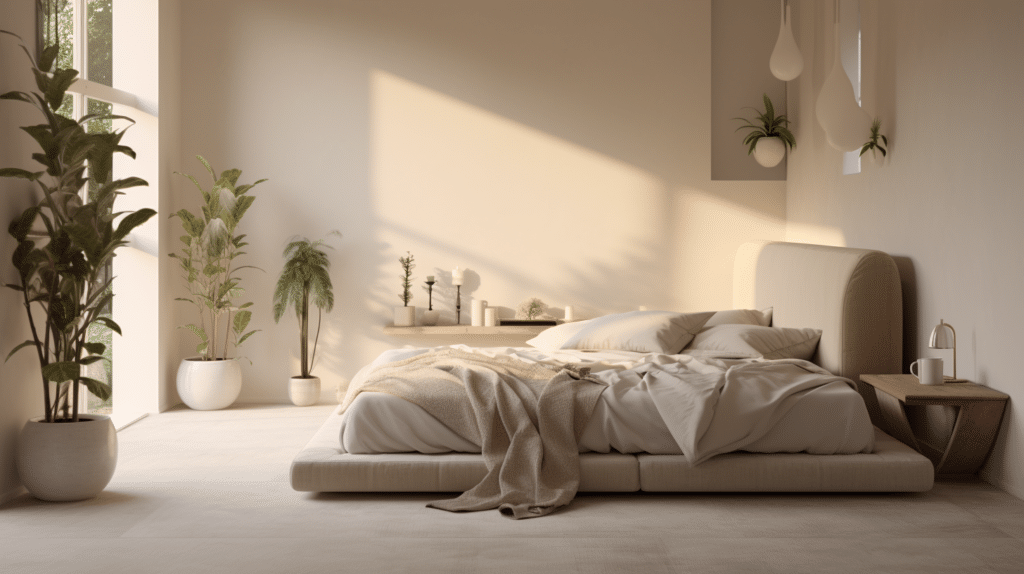Last Updated on August 4, 2023
A bedroom should be more than just a space for rest; it should be a sanctuary that rejuvenates your mind and body while allowing you to escape the stresses of everyday life. Creating a calming bedroom environment is not just about the aesthetics, but also merging different elements such as colour schemes, furniture, textiles, lighting, and personal touches to create a soothing haven perfect for relaxation and sleep.
To achieve this, it’s essential to carefully select the right colours, textures, and design elements, as they all contribute to the overall ambience of the room. From incorporating minimalist principles to using aromatherapy and relaxation techniques, there are many ways to transform your bedroom into a calming and peaceful oasis that supports your emotional well-being and promotes restful sleep.
Key Takeaways
- A calming bedroom integrates various elements like colours, furniture, and design to create a soothing space
- Personal touches, such as artwork and textiles, enhance the room’s ambience and promote relaxation
- Minimalist principles and aromatherapy can be incorporated to achieve an overall sense of calm and tranquillity
Creating a Calming Bedroom Environment
Decluttering and Organisation
One of the essential steps to create a calming bedroom environment is decluttering and organisation. A cluttered room can be distracting and cause feelings of stress, preventing relaxation. Begin by decluttering your bedroom, removing unnecessary items and organising your belongings efficiently. Invest in storage solutions such as shelves, drawers, and under-bed storage to keep your room tidy and maintain a sense of serenity.
Incorporating Natural Materials
Using natural materials in your bedroom can contribute to a calming and relaxing atmosphere. Consider incorporating elements such as wooden furniture, linen or cotton beddings, and woven rugs to create a warm and cozy feeling. Natural materials not only provide a soothing aesthetic but also promote a more sustainable and eco-friendly environment.
Integrating Plants and Greenery
Integrating plants and greenery into your bedroom can help to create a calming oasis. Plants are known to improve air quality, create a sense of tranquillity, and evoke a sense of nature. Choose easy-to-care-for plants like pothos or peace lilies that can thrive in most bedroom conditions. Place them on your nightstand, windowsill, or a corner of your room to create a refreshing and natural ambiance. Incorporating green tones in your room’s colour scheme can also contribute to the calming effect.
Remember, a calming bedroom environment is essential for promoting relaxation and improving sleep quality. By decluttering, incorporating natural materials, and integrating plants, you can transform your bedroom into a serene oasis that fosters a peaceful state of mind.
Calming Colour Schemes
Creating a calming bedroom environment involves choosing the right colour scheme. Here are some popular options to consider for a soothing and serene space.
Neutral Colours
Neutral colours often create a sense of tranquillity in bedrooms due to their soft and muted tones. Shades of white and grey are popular choices for walls, as they evoke a sense of calm without overwhelming the senses. Combining these colours with complementary furnishings and textiles creates a sophisticated and comforting environment, perfect for relaxation.
Blue and Green Hues
Blue and green hues are known for their calming effects, particularly in bedroom settings. These colours evoke feelings of serenity and are reminiscent of nature, which can help reduce stress and anxiety. Some popular options include:
- Dark grey-blue
- Light blue
- Sage green
Blending various shades of blue and green can make the space feel more expansive and enhance the calming atmosphere.
Pastels and Muted Colours
Pastel and muted colours also contribute to a soothing bedroom environment. Soft shades like
- Lavender
- Blush pink
- Pale yellow
These colours add a touch of warmth without overpowering the senses. By combining pastel colours with other calming tones, you can create a harmonious colour scheme that fosters a serene refuge in your bedroom.
Bedroom Furniture and Design
In this section, we will discuss essential aspects of calming bedroom furniture and design, focusing on bed frame and bedding choices, functional and stylish storage solutions, and comfortable and relaxing seating.
Bed Frame and Bedding Choices
Selecting the right bed frame and bedding for your bedroom is crucial for ensuring a calming and relaxing environment. Choose a bed frame that complements the overall design theme and provides adequate support. Opt for a simple design, such as a platform or wooden bed frame, which is known for its minimalist and timeless appeal.
Bedding is another essential element in creating a calming bedroom. Aim for high-quality, breathable materials such as organic cotton or linen. Arrange your pillows and duvet in a visually pleasing manner to provide a sense of comfort and relaxation. Additionally, incorporate soft, neutral colours in your bedding, such as pastels, white, or light grey, to promote a sense of tranquillity.
Functional and Stylish Storage Solutions
In order to maintain a clutter-free and peaceful bedroom, consider incorporating functional and stylish storage solutions. Examples include:
- Floor-to-ceiling built-in wardrobes for an organised and space-saving solution.
- Under-bed storage boxes, perfect for stowing away seasonal clothes or bedding.
- Floating shelves or wall-mounted units for displaying decorative items and books without sacrificing floor space.
These storage solutions not only keep your bedroom tidy but also contribute to the overall aesthetics. Choose materials and finishes that complement your bed frame, bedding, and decor for a cohesive look.
Comfortable and Relaxing Seating
Incorporating comfortable and relaxing seating in your bedroom can greatly enhance your relaxation experience. Consider placing a comfortable chair in a designated reading or resting area, ensuring the chair is suitable for your chosen activity. Include a cosy blanket or decorative cushion in coordinating colours to further enhance the calming atmosphere.
When choosing bedroom furniture, consider the size and layout of the room, and select pieces that provide functionality, comfort, and style, working harmoniously together to create the ideal calming retreat.
Textiles and Accessories
In this section, we will explore various textiles and accessories that can help create a calming bedroom environment. We will discuss pillows and linens, rugs and curtains, and throw blankets, focusing on their importance in promoting relaxation and comfort in the bedroom.
Pillows and Linens
Pillows and linens play a crucial role in creating a comfortable and relaxing sleeping environment. Choosing the right type of pillow for proper head and neck support will help improve sleep quality. Opt for pillows that provide the appropriate level of firmness depending on your sleeping position - a firmer pillow for side sleepers, a medium-firm pillow for back sleepers and a soft, thin pillow for stomach sleepers.
Equally important are the linens that you select for your bed. Look for high-quality materials such as Egyptian cotton or linen, which are both soft and breathable. In addition to material, consider the thread count of your bed linens – aim for a count between 200 and 800 for optimal comfort. Finally, select neutral or soothing colour palettes for your bed linens to create a tranquil atmosphere.
Rugs and Curtains
Rugs and curtains not only serve practical functions in a bedroom, but also contribute to its overall aesthetic and ambiance. A plush rug adds warmth and softness underfoot, creating a more inviting and cosy space. Moreover, rugs can also help dampen noise in the room, promoting a feeling of peace and quiet.
Curtains, on the other hand, regulate the amount of light entering your room. For a calming bedroom, consider blackout curtains or shades that allow you to control the level of natural light during the day and ensure total darkness at night. Furthermore, select curtains with soothing colours and patterns that complement the overall design of your bedroom.
Throw Blankets
Throw blankets are a versatile addition to any bedroom, offering both style and functionality. Drape a soft and cosy throw blanket across your bed for an extra layer of warmth and comfort during the night. Alternatively, you can use a throw to add a pop of colour or texture to your bed, creating a more visually appealing and inviting space.
In conclusion, carefully selecting and incorporating the right textiles and accessories can greatly enhance the comfort and relaxation of your bedroom. By focusing on pillows and linens, rugs and curtains, and throw blankets, you can create a serene and calming environment, ideal for rest and rejuvenation.
Lighting and Ambience
Warm and Soft Lighting
To create a calming bedroom atmosphere, incorporating warm and soft lighting is essential. It achieves a sense of relaxation and can help you unwind before bed. Consider using dimmable bedside lamps, floor lamps, or even soft pendant lights to create a cosy ambiance. You can also opt for warm-toned LED bulbs instead of cool-toned ones for a more inviting glow (bedroom lighting ideas).
Blackout Shades and Privacy Options
Privacy is crucial for a peaceful and serene bedroom. Blackout shades not only block unwanted light from outside but also provide privacy and sound insulation. They can significantly improve your sleep quality and create a soothing environment by allowing complete control over the lighting conditions in your bedroom. Additionally, you may also consider using attractive curtains or blinds that offer adjustable light control and complement your overall bedroom décor (relaxing bedroom ideas).
Ceiling Fans and Air Movement
A well-ventilated room with proper air circulation is vital for relaxation and comfort. Installing a ceiling fan can improve air movement and keep your bedroom cool during warmer months. Look for ceiling fans with silent motors and adjustable speed settings, making them suitable for both day and night use. Opt for fans with integrated lighting to combine functionality and ambient illumination in one (26 relaxing bedroom ideas for a cozier space).
In summary, achieving a calming bedroom environment can be achieved by focusing on warm and soft lighting options, effective blackout shades or privacy solutions, and efficient ceiling fans for air circulation. These elements, combined with a touch of your personal taste and style, will surely create a peaceful and soothing haven for relaxation.
Aromatherapy and Relaxation
Lavender and Other Calming Scents
Lavender is a well-known scent for promoting relaxation and improving sleep quality. It is often used in aromatherapy to create a calming atmosphere in the bedroom. Other calming scents include chamomile, bergamot, and ylang-ylang. These fragrances can be utilised through essential oils, candles, or diffusers to help create a serene environment and make your bedroom a more peaceful space.
Candles and Diffusers
Candles and diffusers are both effective methods of incorporating aromatherapy into your bedroom design. While candles offer a warm, cozy ambiance, diffusers release a steady stream of calming essential oils into the air, allowing you to benefit from their soothing qualities throughout the night. Choose candles or diffusers infused with calming scents, such as lavender, to enhance the relaxing effect.
To ensure that your bedroom remains a safe space, always follow safety guidelines when using candles. These include placing candles away from flammable materials, not leaving them unattended, and extinguishing them before going to sleep.
Incorporating Nature Elements
In addition to calming scents, incorporating nature elements into your bedroom can help create a more relaxing atmosphere. Consider placing peaceful plants in your room to purify the air and bring a sense of tranquility. Choose low-maintenance, air-purifying plants, such as snake plants, pothos, or spider plants, that are easy to care for.
In addition to plants, you can also incorporate natural materials in your bedroom design. Choose bedding made from organic cotton, linen, or bamboo to create a comfortable and eco-friendly sleep space. Select wooden furniture and accessories to add warmth and a connection to nature.
By using calming scents, candles or diffusers, and incorporating elements from nature, you can create a more serene and soothing bedroom environment that promotes relaxation and restful sleep.
Artwork and Personal Touches
Peaceful and Serene Artwork
Incorporating peaceful and serene artwork into your bedroom design can create a calming atmosphere for rest and relaxation. For example, selecting pieces that showcase soothing colours, nature scenes, or abstract shapes can evoke a sense of tranquillity. Calming art can include watercolour paintings, minimalist drawings or even wall sculptures that feature soothing textures or materials. Make sure the chosen artwork seamlessly integrates with the overall colour scheme and style of your bedroom.
Family Photos and Personal Items
Adding family photos and personal items to your bedroom helps create a comfortable, inviting space that reflects your personality and connects you to your treasured memories. Consider tastefully arranging a mix of framed photos, cherished keepsakes, and souvenirs on shelves, bedside tables, or walls, as long as they don’t add visual clutter or stress-inducing reminders. To maintain a calming environment, choose neutral or complementary frames and keep the arrangements of items balanced and orderly.
Strategic Accent Walls
Creating a strategic accent wall can have a significant impact on the overall ambiance of your bedroom by drawing attention to a focal point and contributing to the cohesion of the space. When designing an accent wall, consider the use of calm, soothing colours and incorporate elements such as artwork or textured materials like wood, fabric, or wallpaper. The accent wall should enhance the room’s look without overwhelming it, and it’s important to strike the right balance between colour, texture, and visual weight to maintain the calm, serene atmosphere of your bedroom.
Incorporating Minimalist Principles
Elegant and Simplistic Decor
Incorporating minimalist principles into your bedroom’s interior design can create a calming space to relax and unwind. To achieve this, opt for simple and clean lines in your furniture, and use a limited color palette of neutrals or earth tones. Introduce texture through natural materials like wood and iron to add warmth and charm to the room. Consider decluttering your space and removing any unnecessary items to maintain the clean and inviting atmosphere that minimalist design encourages.
Practising Feng Shui
Feng shui is an ancient Chinese practice that aims to balance energy flow within spaces. To practise feng shui in your minimalist bedroom, focus on arranging furniture and objects in a way that supports the flow of positive energy. Ensure that your bed is easily accessible from both sides, and position it to have a clear view of the room’s entrance. You should also avoid placing heavy objects or mirrors opposite the bed, as it can create a sense of instability.
Reducing Noise and Distractions
Creating a calm and peaceful environment in your bedroom is essential for achieving restful sleep. Reducing noise and distractions can help you feel more relaxed and promote better sleep quality. Some strategies to reduce noise and distractions in your bedroom include:
- Using soft textiles: Thick rugs and curtains can help absorb sound and block out unwanted noise.
- Optimising window placement: Make sure your windows are well-insulated to block out external noise, and consider upgrading to double-glazing if necessary.
- Using a noise machine: If your environment is exceptionally noisy, consider investing in a noise machine that generates soothing sounds such as ocean waves or gentle rain to mask any unwanted noise while you sleep.
Incorporating minimalist design principles, practising feng shui, and reducing noise and distractions can significantly contribute to creating a calming bedroom that promotes relaxation. Keeping the room clean and clutter-free will not only make it visually appealing but also help maintain the serene and soothing atmosphere necessary for restful sleep.
Final Thoughts on Achieving a Calming Bedroom
Seeking Professional Advice
If you are struggling to create a calming bedroom on your own, consider seeking advice from an interior designer. These professionals can provide valuable insights into selecting appropriate bedroom colours and elements that contribute to a serene atmosphere. A skilled interior designer can help you choose a colour palette based on neutrals or other hues that evoke a sense of serenity and calmness.
Frequently Asked Questions
What are some budget-friendly calming bedroom ideas?
Budget-friendly ideas to create a calming bedroom include rearranging your furniture to optimize flow and natural light, decluttering, and repurposing or upcycling existing items. Additionally, consider adding small touches like low-cost artwork, plants, or a cosy throw blanket.
How can I design a calming bedroom for an autistic individual?
When designing a calming bedroom for an autistic person, prioritize sensory-friendly elements, such as soft textures, gentle lighting, and minimal patterns or colours. Ensure the room is functional, clutter-free, and provides a soothing environment tailored to the individual’s specific sensory needs and preferences.
What are some key features of a Zen bedroom?
A Zen bedroom typically includes minimalist design, natural materials, earthy colours, and clean lines. Maximize natural light and incorporate elements of nature, such as plants or water features, to create a sense of balance and tranquillity.
How can I turn my master bedroom into a relaxing sanctuary?
To transform your master bedroom into a sanctuary, focus on creating a peaceful and inviting atmosphere through the use of calming colours, high-quality bedding, and comfortable furnishings. Opt for soft lighting and incorporate plants or candles for an additional soothing effect. Remove distractions, such as electronic devices, and ensure the space is clean, organized, and clutter-free.



